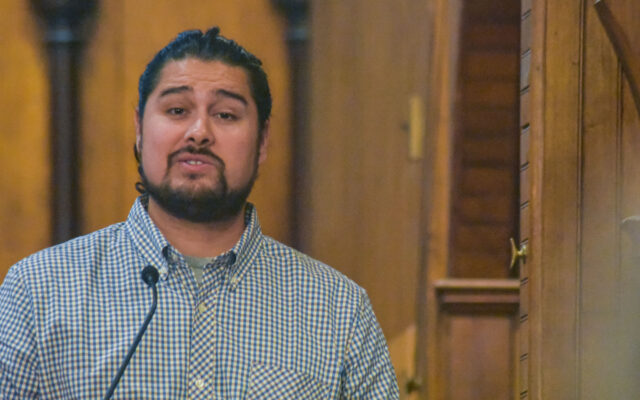
HOULTON, Maine — The Wolastoqey family networks and nationhood never fit neatly into the United States or Canada in the way history books explain, said Osihkiyol Crofton-Macdonald the Houlton Band of Maliseets tribal ambassador.
“I’m a Wolastoqey person from the Houlton Band of Maliseets in Maine and the Oromocto First Nation in New Brunswick, Canada,” he said to about 60 people at the Church of the Good Shepherd in Houlton on Tuesday night.
.
Crofton-Macdonald shared personal and historical details of an invisible history missing from Maine’s classrooms. It is a story of how his nation, his family, endured the ravages of a sometimes dark and grim history erased from most written records.
It is a story that Crofton-Macdonald is resurrecting so others will know about the people who lived for thousands of years in this northern region long before international borders, statehood or French and British settlers arrived.
“This may be the first time you heard Wolastoqey. It means the people of the good river,” he said, explaining that Maliseet is actually a Mi’kmaq name, meaning slow talkers. “We call ourselves Wolastoqey.”
It is often mistakenly taught that the native communities across the border are a separate nation from the ones on this side, he said.
“I’d like to clear up some confusion. Each of our Wolastoqey communities are one part of a much larger Wolastoqey Nation.”
He shared the story of his late uncle, a basketmaker in Mars Hill.
“He regularly traveled along traditional routes to sell his baskets in New Brunswick,” Crofton-Macdonald said. “I don’t think he ever considered it international travel. To him, he was just traveling our own land the way we have always done.”
The traditional Wolastoqey territory extends the entire St. John River watershed from its headwaters in Quebec through Aroostook County to southern and eastern New Brunswick and out to the Atlantic Ocean, Crofton-Macdonald said, adding that the Wolastoqey actually call the St. John River, the Wolastoq River and they are the people of the Wolastoq.
“To this day we have Wolastoqey people living throughout the entirety of this territory,” he said. “We have a community in Quebec, six communities in New Brunswick and many Wolastoqey people living throughout Aroostook County.”
The Houlton Band of Maliseets reservation is the only federally recognized community. But the Wolastoqey Nation has people spread throughout the county including those not recognised by the state or federal government, Crofton-Macdonald said.
Some moved to reservation lands, but many Wolastoqey families, much more than the history books explain, refused to move from their homes in Aroostook County, he said.
“We lived in poverty in tar paper shacks with dirt floors, working in seasonal potato harvesting on farms that we did not own, on land that had never been legally purchased or ceded from us,” he said.
The families that refused to leave their homes in Aroostook County banded together to form the Aroostook Association of Indians and eventually the Houlton Band of Maliseet Indians, he said.
With the exception of a few documents found in an old shoebox, the history of the Wabanaki Tribes – the Penobscot, the Passamaquoddy, the Mi’kmaq, the Houlton Band of Maliseets – and the Wolastoqey Nation is missing from colonial treaties. And it is rarely part of Maine school curriculums, despite a two decades-old law that mandates all K-12 schools teach accurate Maine Native American history and culture.
Last fall, a report released by the Wabanaki Alliance, the American Civil Liberties Union, the Abbe Museum and the Maine Indian Tribal-State Commission, found that the state’s Department of Education failed to meet the requirements of that law.
Most Maine schools, with the exception of Portland and Calais, did not teach the state-required history and many schools referred to Wabanaki people in the past tense as if they no longer exist, according to the report.
Additionally, history textbooks invalidate indigenous views, supporting colonialist narratives of violence and lawlessness by indigenous people, the report detailed.
Crofton-Macdonald stressed the importance of preserving the culture through their language because in Maine, attempts to dispossess the Wolastoqey people of their territory included removing them from their language and place names, he said.
During the presentation, an audience member asked him about the residential schools that stole thousands of indigenous children from their families.
“We have all been devastated by this. My Gram was taken from her home to a school in Nova Scotia,” he said. “When she left that school, she ran and that’s how we ended up in the United States. She ran trying to find something better. A lot of our families have that history.”
Just last week, the Catholic Church released a list of 87 Catholic-run Native boarding schools across 22 states.
“This list is a powerful step forward,” said Maka Black Elk, executive director for Truth and Healing at Red Cloud Indian School, who contributed to the compilation of the list.
Another audience member asked if there is a window of hope to fix what has been broken, a way to make amends.
Crofton-Macdonald said there is a lot to be hopeful for and in the past 20 years there has been monumental growth.
“I am able to stand here and talk about this because of the elders who paved that path before me,” he said. “I’ve been standing on the shoulders of giants. The way we navigate all of this is to look to the future and try to make a future that’s better for all of us.”







